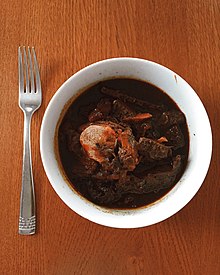Guyanese pepperpot
 | |
| Type | Stew |
|---|---|
| Place of origin | Guyana |
| Main ingredients | Meat (beef, pork, mutton), cinnamon, hot peppers, cassareep |
Pepperpot is an Amerindian-derived dish popular in Guyana. It is traditionally served at Christmas and other special events. Along with chicken curry, and cook-up rice, pepperpot is one of Guyana's national dishes.[1]
This dish is usually reserved for special occasions because it needs to cook for several hours, and mostly eaten on Christmas Day or during the Christmas holiday season, and sometimes on Boxing Day. Like the original Amerindian version it is usually made in a large pot and can be reheated and eaten over several days because the cassareep starts preserving the meat.[2]
Traditionally, the dish is made using wiri wiri chilli peppers (a Capsicum frutescens cultivar native to Guyana) but due to low availability outside of the country, scotch bonnet or habanero peppers are commonly accepted substitutes due to their similar spice level and fruitiness.
See also
[edit]References
[edit]- ^ Albala, Ken (2011). Food Cultures of the World Encyclopedia. ABC-CLIO. p. "national+dish" 161. ISBN 978-0-313-37626-9.
- ^ Goucher, Candice (2014). Congotay! Congotay! A Global History of Caribbean Food. Taylor & Francis. p. 57. ISBN 978-1-317-51732-0.
- Jabar, Bibi Sazieda (2011). Guyanese Style Cooking. iUniverse. pp. 7–. ISBN 978-1-4620-6337-6.
- Phang, Jonathan (2008). "Guyanese Pepperpot". In Worrall Thompson, Antony; Rankin, Paul (eds.). The People's Cookbook: A celebration of the nation's life through food. Infinite Ideas. pp. 69–. ISBN 978-1-907755-09-5.
- Smock, Kirk (2008). The Bradt Travel Guide: Guyana. Bradt Travel Guides. pp. 22–. ISBN 978-1-84162-223-1.
- Walcott, Michael (2005). A Cathedral Inside: Odyssey of a Guyanese Family. Michael Walcott. pp. 102–. ISBN 978-1-4196-0574-1.
- Duford, Darrin (Winter 2012). "Journey by Bottle: Uncovering the Allure of Guyanese Cassareep". Gastronomica: The Journal of Critical Food Studies. 12 (4). University of California Press: 27–30. doi:10.1525/GFC.2012.12.4.27.
